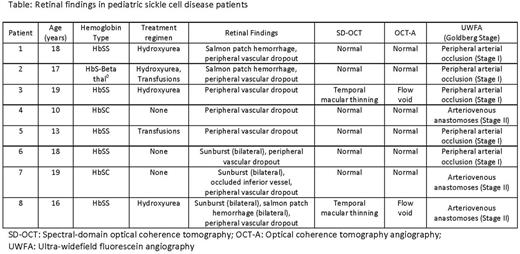Abstract
Introduction: Sickle cell retinopathy (SCR) reflects disease-related vascular injury. Previous studies of pediatric SCR using standard imaging approaches reported retinopathy in <15% of children (Estepp JH, Br J Haematol 161:402;2013). Sensitive clinical retinal imaging modalities of ultra-widefield fluorescein angiography (UWFA), spectral-domain optical coherence tomography (SD-OCT), and optical coherence tomography angiography (OCT-A) may better characterize early retinal changes in pediatric SCR. Fluorescein angiography detects retinopathy through dynamic visualization of retinal blood flow. UWFA captures up to twice as much retinal area as conventional fluorescein angiography and is more sensitive in identifying peripheral vascular changes in SCR (Friberg TR, Ophthalmic Surg Lasers Imaging 39:304;2008). SD- OCT and OCT-A utilize reflected light to produce detailed cross-sectional images of the retina and allow visualization of blood flow in retinal layers. To our knowledge, this is the first case series using these technologies in pediatric SCR. Methods: A consecutive series of children with sickle cell disease (SCD) of any phenotype, ages 10-19 years, accepting enrollment are described. Examinations including acuity, standard slit-lamp examination (biomicroscopy), UWFA, SD- OCT and OCT-A were performed according to standard acquisition protocols. Testing is non-invasive except fluorescein angiography, which requires a small volume of intravenous dye.
Results: Eight children (mean age 16.3 years; 5 HbSS, 2 HbSC,1 HbS-Beta thalassemia0) were evaluated. Three were on hydroxyurea therapy, 1 on chronic transfusion, 1 on both and 3 on no therapy. No patient had vision disturbance at the time of examination. Biomicroscopic examination revealed sunburst lesions in the mid-peripheral retina in 3 patients and subtle vascular changes in the far periphery of all patients. In contrast, UWFA detected extensive capillary non- perfusion of the peripheral retina with abnormal vascular loops (Goldberg Stage I) in all 8 patients; 3 patients had peripheral arteriovenous anastomoses (Goldberg Stage II) that were undetectable by biomicroscopy. No patient had Goldberg Stages III-V. SD-OCT demonstrated thinning of the temporal macula in 2 patients, and OCT-A of both patients revealed flow voids in both the superficial and deep retinal capillary plexus in the area of thinned retina. Both the SD- OCT and OCT-A abnormalities were undetectable with standard biomicroscopy.
Conclusions: All 8 children with SCD in this case series demonstrated evidence of SCR using the combination of standard biomicroscopy, UWFA, SD-OCT, and OCT-A imaging. Findings from these sensitive imaging modalities suggest that pediatric SCR is more prevalent than previously suspected. Additional patients and age-equivalent controls will be included in this report to validate the specificity of findings to SCD. Larger cross-sectional and prospective analyses using sensitive retina imaging are needed to confirm our findings and identify their significance for detecting pathology. If confirmed, these approaches may enhance early screening for patients at risk of vision-threatening consequences of SCR.
Supported by the Irving Institute CTSA at CUMC and by 2T35HL007616 (DP).
Retinal findings in pediatric sickle cell disease patients
SD-OCT: Spectral-domain optical coherence tomography; OCT-A: Optical coherence tomography angiography; UWFA: Ultra-widefield fluorescein angiography.
Retinal findings in pediatric sickle cell disease patients
SD-OCT: Spectral-domain optical coherence tomography; OCT-A: Optical coherence tomography angiography; UWFA: Ultra-widefield fluorescein angiography.
No relevant conflicts of interest to declare.
Author notes
Asterisk with author names denotes non-ASH members.


